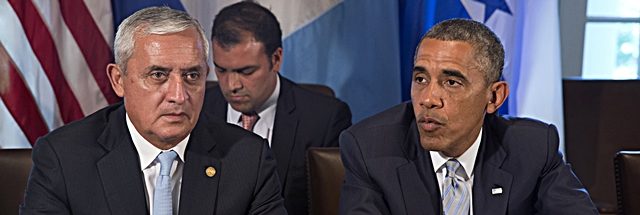Guatemala’s president: $2 billion ought to help border crisis

GIMME, GIMME: Guatemala’s President Otto Perez Molina, left, wants $2 billion to stop the flood of people coming from his country into the U.S. President Obama met Friday in Washington, D.C. with Molina, El Salvador’s President Salvador Sanchez Ceren and Honduran President Juan Hernandez to discuss the border crisis.
By Marianela Toledo | Florida Watchdog
MIAMI — Guatemalan President Otto Perez Molina says $2 billion in federal aid and other U.S. investment in Central America could help end the flood of migrants across the U.S. southern border.
But it’s a fool’s game, says the leader of a charity serving immigrants from Honduras.
“I think giving money to these governments is a serious mistake,” said Francisco Portillo, president of the Honduran Francisco Morazan Integrated Organization in Miami
“Corruption in our country (Honduras) is huge, no limits. And the money they are talking about is coming from our taxes,” he said.
Giving money to Central American governments in Guatemala, Honduras and El Salvador is basically the same as throwing it away, he said.
Instead, Portillo said, President Obama and the U.S. Congress should “ensure it is spent on helping these children who are returned to their countries.”
PRAY: Francisco Portillo, left, president of the Francisco Morazan Honduran Integrated Organization, says sending more money to Central American governments will not stop the flood of migrants rushing the U.S. southern border.
Guatemala’s Molina said to “attack the root of the problem,” the U.S. needs ” to think about making investments in countries such as Guatemala, El Salvador and Honduras.”
Since 2008, according to a Washington Post report, the U.S. has sent about $528 million to the three countries for security and law enforcement. The U.S. Agency for International Development in 2012 spend $148.4 million among the three countries for education, economic development, democracy, environment, heath and more.
But far from improving, things have gotten worse.
We talked with one person who made it across the border in recent weeks, fleeing what she said is the burgeoning gang culture in her native Honduras.
Ingrid, who asked that her last name not be used because she fears reprisals, said gangs threatened to kill her children if she did not pay.
“If I had not received threats about her,” she says, pointing to her daughter, “I wouldn’t have come.
“We came because they were going to take her because we didn’t have money to pay the ‘rent.’”
“Rent” is what the gangs charge people to let them live.
Ingrid said people who complained or refused to pay the gangs were killed.
“You cannot complain there (in Honduras). A lady went (to file a complaint with the police department) and when she returned home, she and her family were murdered.”
Despite the huge outlays of cash from the United States, violence and murder rates continue to climb.
The U.S. State Department data show 79 murders per 100,000 people in Honduras, among the highest murder rate in the world. El Salvador’s homicide rate has been rising steadily since August 2013. And it’s not subsided this year. From mid-February through April, an average 10 people were killed each day, the highest homicide rate since 2011.







